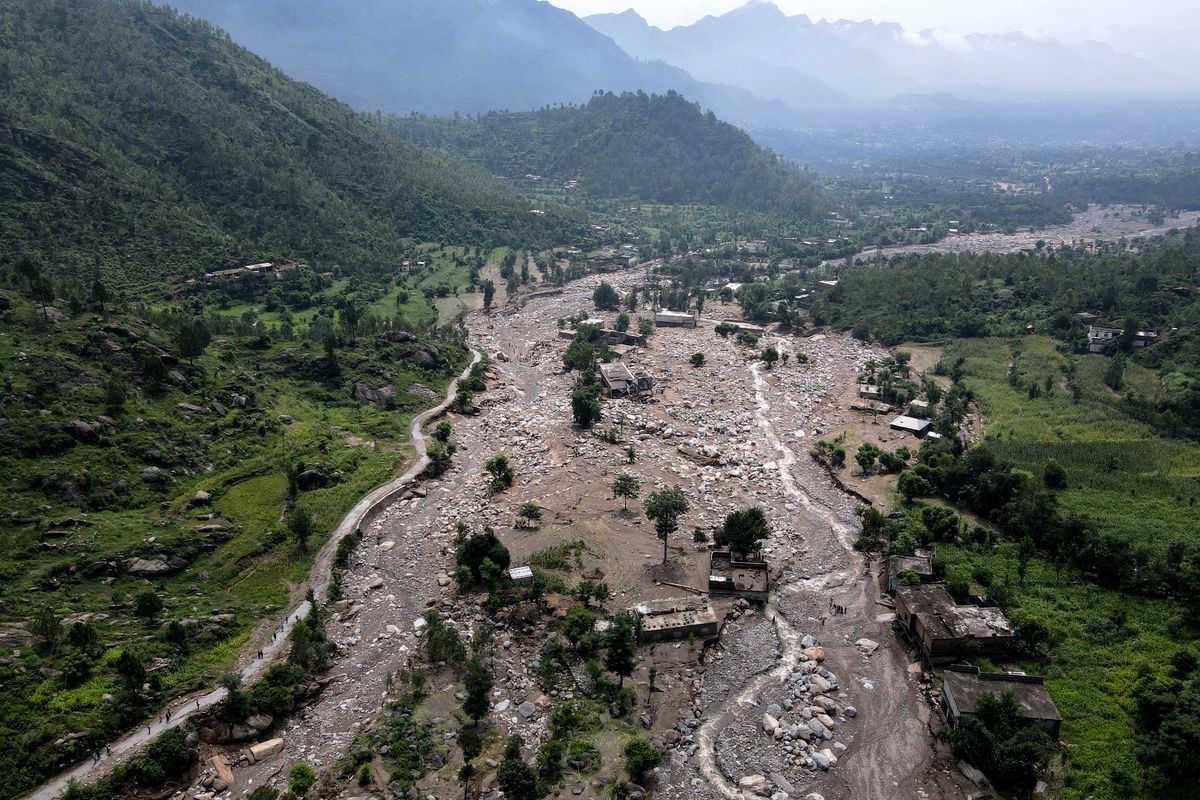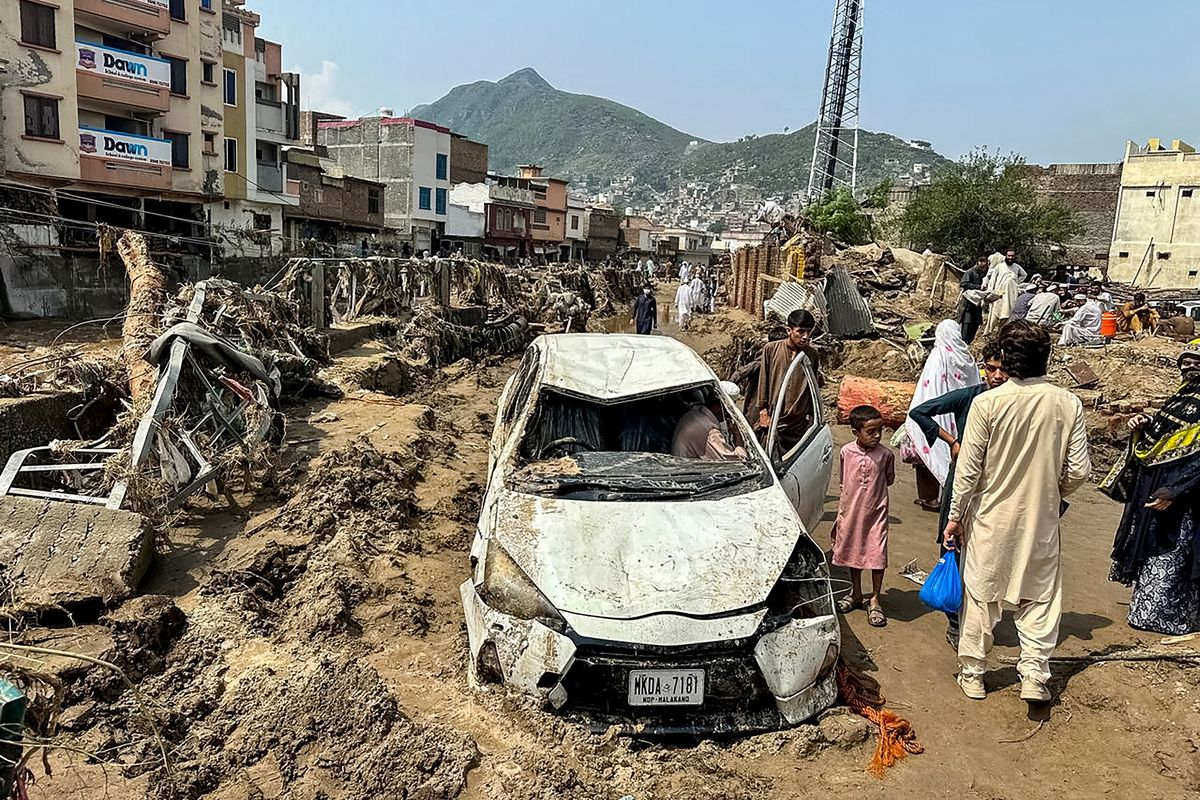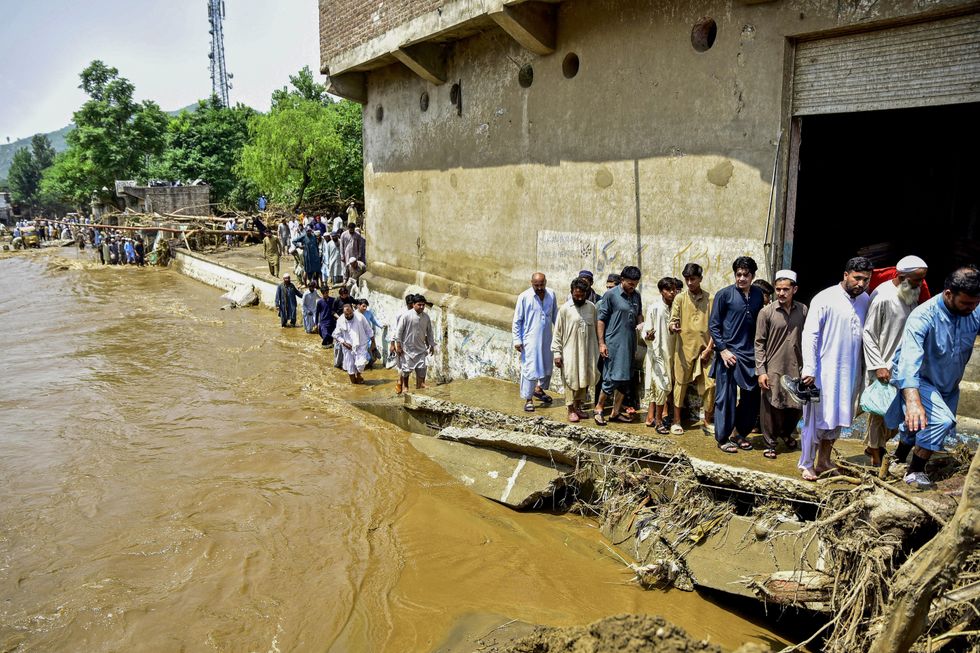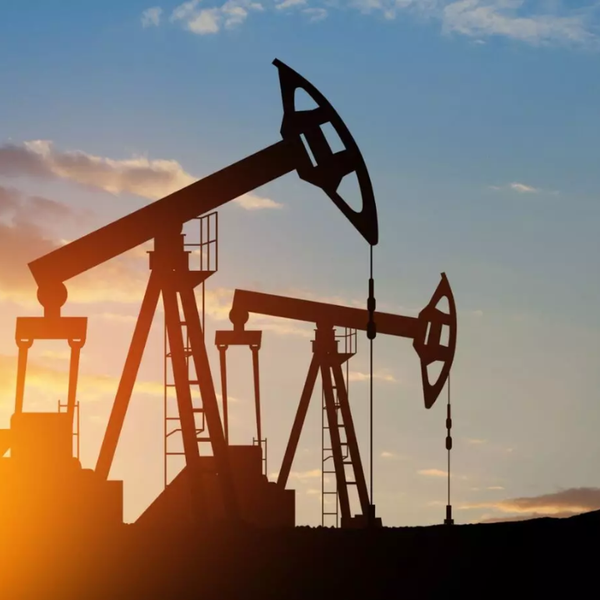Pakistan floods kill 670 as more monsoon spells loom
Authorities warn floods could worsen as two more severe monsoon spells are expected in coming weeks

Asma Kundi
Producer, Islamabad
Asma Kundi is a multimedia broadcast journalist with an experience of almost 15 years. Served national and international media industry as reporter, producer and news editor.

An aerial view shows houses partially submerged in sludge along a riverbed in the aftermath of flash floods at the Buner district of mountainous Khyber Pakhtunkhwa province on August 17, 2025.
AFP
At least 670 people have been killed and nearly 1,000 injured in monsoon-related floods across Pakistan, officials said on Monday, warning the country is bracing for two more severe rain spells before the season ends in late September.
National Disaster Management Authority Chairman Lt. Gen. Inam Haider, speaking at a joint briefing with Information Minister Attaullah Tarar and Climate Change Minister Musaddiq Malik, said the country is currently experiencing its seventh monsoon spell of 2025.
“So far, nearly 670 lives have been lost, and about 1,000 people are injured and receiving treatment,” Haider said. “Around 80 to 90 people are still missing, and if ongoing search efforts fail, these numbers could add to the casualty figures.”
He warned the current spell will likely intensify around Aug. 22-23, bringing localized heavy downpours and possible cloudbursts. “Two more monsoon spells are expected — one from Aug. 23 until the end of the month and another during the first 10 days of September,” Haider said. “These will be critical periods, after which we expect the situation to normalize by the end of September.”
- YouTube www.youtube.com
Haider explained that monsoon emergencies in Pakistan are driven by two primary factors: horizontal flows, caused by rapidly melting glaciers, and vertical flows, caused by intense rainfall and cloudbursts linked to global weather systems. “If these two combine — glacier melt with heavy cloudbursts — the situation becomes extremely dangerous, as seen in the devastating floods of 2022,” he said.
Relief and rescue efforts underway
The NDMA chief said more than 425 relief camps have been activated nationwide, offering medical services, emergency treatment, and temporary shelter in public buildings and schools. “Our priority is to save lives and evacuate people from high-risk areas to safe locations,” Haider said.
Under the Prime Minister’s special ration program, trucks carrying food and relief supplies are being dispatched to Khyber Pakhtunkhwa, Gilgit-Baltistan, and other flood-hit areas.

“The Pakistan Army has deployed specialized engineering units and medical teams to assist with search and rescue operations, while major hospitals, including Combined Military Hospitals, have been placed on high alert,” Haider said. Field ambulances and early warning units have been integrated into the NDMA’s National Emergency Operation Center, which operates around the clock to coordinate response efforts.
Initial surveys in Gilgit-Baltistan have been completed, and assessments in Khyber Pakhtunkhwa are underway to determine damage to homes, roads, and critical infrastructure such as bridges.
“Once the monsoon season ends, we will have a comprehensive national damage report, which will form the basis for a Prime Minister-approved national compensation package,” Haider said.
Climate inequity and Pakistan’s vulnerability
Climate Change Minister Musaddiq Malik used the briefing to highlight global climate injustice, noting Pakistan contributes less than 1% of global greenhouse gas emissions but remains among the most vulnerable to climate-related disasters.
“The hypocrisy of the global system is evident. The top seven or eight countries produce 70-75% of the world’s emissions, yet they take 85% of global climate finance,” Malik said.
- YouTube www.youtube.com
“These emissions are melting our glaciers, triggering lake bursts, and causing intense cloudbursts. Meanwhile, the countries responsible for this crisis are securing investments for their own green initiatives, leaving frontline states like Pakistan underfunded,” he said.
Malik called for an integrated early warning system, faster climate resilience projects, and the relocation of vulnerable communities near waterways. “What you call streams are actually torrents during monsoon, carrying water and debris from mountains,” he said. “Settlements near these waterways are highly dangerous and must be moved to safer ground.”
Coordinated national response
Information Minister Attaullah Tarar emphasized that Prime Minister Shehbaz Sharif is personally monitoring the situation and has directed strong federal-provincial coordination.
“This is a national emergency, and the government is fulfilling its responsibility in partnership with the armed forces and humanitarian organizations,” Tarar said.
He stressed that the government’s strategy includes rescue, relief, reconstruction, and capacity building. “Our goal is to build a resilient Pakistan, prepared for climate-driven challenges,” he said.
‘Even a little rain scares us now’
Many people fled to seek shelter under damaged infrastructure and in the mountains in Buner, an area with difficult terrain.
“Even if it rains a little now, we feel scared because there was light rain that day. And then the unsuspecting people were swept away by the storm,” said Buner resident Ghulam Hussain, 35.
“Children and women are running and screaming up the mountains to escape,” Hazrat Ullah, 18, told AFP.
Volunteer Ahmad said there were also fears for the future due to a lack of food supplies and clean water.

“Many livestock have also perished in the cloudburst, and their decomposing bodies are spreading a foul odour in several places. Right now, our most urgent need is clean drinking water, and I appeal to the government to provide it,” he said.
The monsoon season brings about three-quarters of South Asia’s annual rainfall, which is vital for agriculture and food security but also causes widespread destruction.
According to the National Disaster Agency, the intensity of this year’s monsoon is about 50 to 60 percent higher than last year.
Landslides and flash floods are common during the monsoon season, which typically begins in June and lasts until the end of September.
Pakistan is among the world’s most vulnerable countries to the effects of climate change and is increasingly facing extreme weather events.
In 2022, monsoon floods submerged one-third of the country and resulted in approximately 1,700 deaths.
—With additional input from AFP







Comments
See what people are discussing